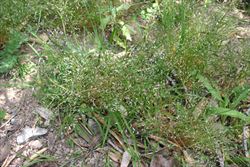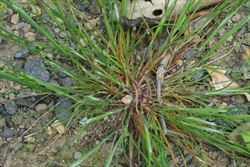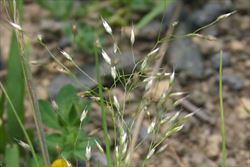Click on images to enlarge

infestation (Photo: Trevor James)

habit (Photo: Trevor James)

stems and leaves (Photo: Trevor James)

seed-heads (Photo: Trevor James)

close-up of flower spikelets (Photo: Trevor James)
Scientific Name
Aira caryophyllea L.
Family
Gramineae (South Australia)Poaceae (Queensland, New South Wales, the ACT, Victoria, Tasmania, Western Australia and the Northern Territory)
Common Names
hair-grass, silver hair grass, silver hairgrass, silvery hair-grass, silvery hairgrass
Origin
Native Europe, the Azores, the Madeira Islands, the Canary Islands, many parts of Africa (i.e. Algeria, Morocco, Tunisia, Ethiopia, Kenya, Tanzania, Uganda, Cameroon, Nigeria and Malawi), and western Asia (i.e. Cyprus, Turkey and southern Russia).
Naturalised Distribution
Widely naturalised in the temperate regions of southern Australia. This species is most common in southern and central New South Wales, the ACT, Victoria, Tasmania, south-eastern South Australia and south-western Western Australia. It is also occasionally naturalised in other parts of Western Australia, South Australia and New South Wales. Silvery hairgrass (Aira caryophyllea) has also been recorded in south-eastern Queensland, though not for many years, and is possibly also naturalised in the southern parts of the Northern Territory.
Widely naturalised in other parts of the world, including in southern Africa, New Zealand, the USA, Canada, Mexico, South America and Hawaii.
Notes
Silvery hairgrass (Aira caryophyllea) is regarded as an environmental weed in Victoria and Western Australia. It is also common in many other parts of south-eastern Australia and its impact on natural areas in these states may be under-estimated. This species is quite small and may appear harmless, however it can grow in very dense populations that exclude native groundcover species and prevent their regeneration.
In Victoria, silvery hairgrass (Aira caryophyllea) is thought to be a serious threat to one or more vegetation formations. It is common in many types of native plant communities, including heathy herb-rich woodlands and damp herb-rich woodlands in the Wimmera bioregion, lateritic woodlands in the Goldfields bioregion and estuarine wetlands, damp herb-rich woodlands and dry valley forests in the Gippsland bioregion. This species has been recorded from numerous conservation areas in Victoria (e.g. Morwell National Park, Blacks Creek Nature Conservation Reserve, Phillip Island Nature Park and Lady Julia Percy Island State Faunal Reserve) and is listed as a serious environmental weed by some local authorities (e.g. Knox City, Banyule City, Manningham City and Mornington Peninsula Shire).
Silvery hairgrass (Aira caryophyllea) is also ranked as a moderately important environmental weed in the Environmental Weed Strategy of Western Australia. It has the ability to invade bushland in good to excellent condition and is thought to have a wide potential distribution in this state. This and other hairgrasses (Aira spp.) are very common or abundant weeds of pastures and many types of bushland in southern Western Australia. Silvery hairgrass (Aira caryophyllea) is most commonly found on poorer soils and often grows in winter-wet claypans in in this state.
This species is generally not seen as a threat by local and regional authorities in New South Wales, even though it is widespread in pastures and disturbed grasslands in this state. However, it is a common weed of natural temperate grasslands in the southern tablelands region, which is listed as an endangered ecological community in New South Wales and the ACT. This species is now a common component of these remnant grasslands, and at first glance it may not seem to be threatening the integrity of the surviving native plants. However, it and other weed similar species may be replacing or out-competing annual or spring-flowering indigenous species and could be having as impact on native species richness and diversity.
Silvery hairgrass (Aira caryophyllea) is also widespread in grasslands in South Australia. It is predominantly found in disturbed sites, but also grows in open woodlands, coastal heathlands and floodplains. It has also been recorded in some conservation areas in thuis state (e.g. in Naracoorte Caves Conservation Park, Little Mount Crawford Native Forest Reserve and Kangaroo Flat Native Forest Reserve).
This species is also a weed of coastal vegetation, heathlands, woodlands, riparian habitats, wetlands, rock outcrops, pastures, old lavafields and sub-alpine shrublands in Hawaii.

